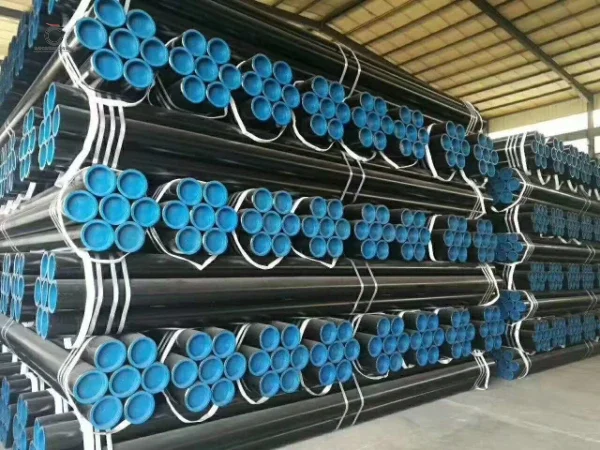Cold drawn seamless steel pipe shaft parts and quality
The length-to-diameter ratio of the shaft is less than 5 is called short shaft, more than 20 is called slender shaft, and most of the shafts are in between.
The shaft is supported by bearings, and the shaft section that fits with the bearings is called journal. Journals are the assembly benchmark of shafts, and their accuracy and surface quality are generally required to be high. Their technical requirements are generally formulated according to the main functions and working conditions of shafts, which are usually as follows.
(A) cold-drawn seamless steel pipe size accuracy The journals that play a supporting role in order to determine the position of the shaft, usually have high requirements for its size accuracy (IT5 ~ IT7). The size accuracy of the journals of the assembled transmission parts is generally required to be lower (IT6~IT9).
(B) the geometric shape accuracy of cold drawn seamless steel pipe shaft parts geometric shape accuracy is mainly refers to the journal, external taper, Morse taper hole, such as roundness, cylindricity, etc., should generally be limited to its tolerance within the size tolerance. The inner and outer circular surfaces with high accuracy requirements should be marked on the drawings with their allowable deviations.
(C) the mutual position accuracy of cold drawn seamless steel pipe shaft parts position accuracy requirements are mainly determined by the position and function of the shaft in the machinery. Usually should ensure that the assembly transmission parts of the journal to the support journal coaxiality requirements, otherwise it will affect the transmission precision of the transmission parts (gears, etc.), and generate noise. The radial runout of the supporting journals of the mating shaft section is generally 0.01~0.03mm for ordinary precision shafts, and 0.001~0.005mm for high-precision shafts (such as spindles).
(D) cold-drawn seamless steel pipe surface roughness generally with the transmission parts with the shaft diameter surface roughness of Ra2.5 ~ 0.63μm, with the bearing with the support shaft diameter of the surface roughness of Ra0.63 ~ 0.16μm.

Cold drawn seamless steel pipe is divided into general steel pipe, low and medium pressure boiler steel pipe, high pressure boiler steel pipe, alloy steel pipe, stainless steel pipe, petroleum cracking pipe, other steel pipe, but also includes carbon thin-walled steel pipe, alloy thin-walled steel pipe, stainless thin-walled steel pipe, shaped steel pipe. Hot-rolled seamless pipe outer diameter is generally greater than 32mm, wall thickness 2.5-75mm, cold-drawn seamless steel pipe outer diameter can be up to 6mm, wall thickness can be up to 0.25mm, thin-walled pipe outer diameter can be up to 5mm, wall thickness less than 0.25mm, cold-drawn than hot-rolled high dimensional accuracy.
Cold-drawn seamless steel pipe quality improvement methods
1.optimize the heating process
Heating temperature is too high or too long, will cause iron oxide adherence in the cold-drawn seamless pipe billet matrix surface is difficult to remove. In order to avoid the heating caused by phosphorus removal is not net, in order to meet the conditions of the production process, sub-grade steel, specifications of the billet heating time to optimize the adjustment.
2.the fine phosphorus removal process
Four times phosphorus removal in the rough rolling stage to ensure that a clean iron oxide will be removed. In the fine rolling stage in accordance with the thickness of the cold-drawn seamless pipe to increase the number of times the fine phosphorus removal, 20-30mm thickness specifications rolling at least one additional fine phosphorus removal, and more than 30mm thickness specifications to increase the number of times. In addition, at least one increase in the volume of rolling before rolling, so that the total number of phosphorus removal process is not less than the number of provisions to ensure that the effect of phosphorus removal.
3.cooling intermediate billet laminar flow
Intermediate billet laminar flow cooling process, after rolling steel plate plate shape is good, after laminar flow cooling surface is greenish gray, dense, the surface quality has been improved.
4.increase the length of the billet
The head and tail materials are designed to be lengthened, and the head and tail of the shaped pipe plate are changed to one agreement material each, and the middle steel plate is cut and received according to the material, so the head and tail quality defects can be basically solved.
5.Improve the production process
On the basis of improved rolling control level, different thickness specifications can be selected for flat rolling process rolling. This shortens the rolling time, reduces the oxidation time in the high-temperature section, and improves the surface quality of cold-drawn seamless pipes.
6.adjustment of coiling furnace temperature
In the case of satisfying the coiling conditions, appropriately reduce the coiling furnace temperature, combined with the rolled product steel type, specification thickness and section width, fine adjustment of the coiling furnace temperature to reduce the frequency of defects arising from the coil knot tumor bring out.
7.optimize the final rolling temperature
On the premise of ensuring the performance of cold-drawn seamless pipe, the final rolling temperature is appropriately increased to improve the plasticity of iron oxide on the surface.
Cangzhou Shenlong Pipe Manufacturing Co., Ltd. is an enterprise specializing in the production, processing and sales of various steel pipes and pipe fittings, with its production base located in Cangzhou, Hebei Province. The production base is located in Cangzhou, Hebei Province, China. It was founded in 1992, covering an area of more than 60,000 square meters, with more than 200 employees (including 30 inspectors) and an annual production capacity of about 150,000 tons of steel pipes and 40,000 tons of pipe fittings.






